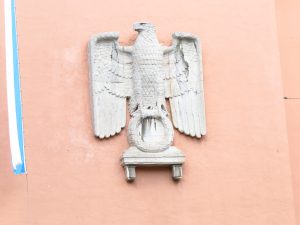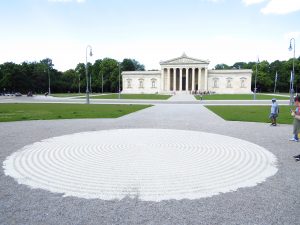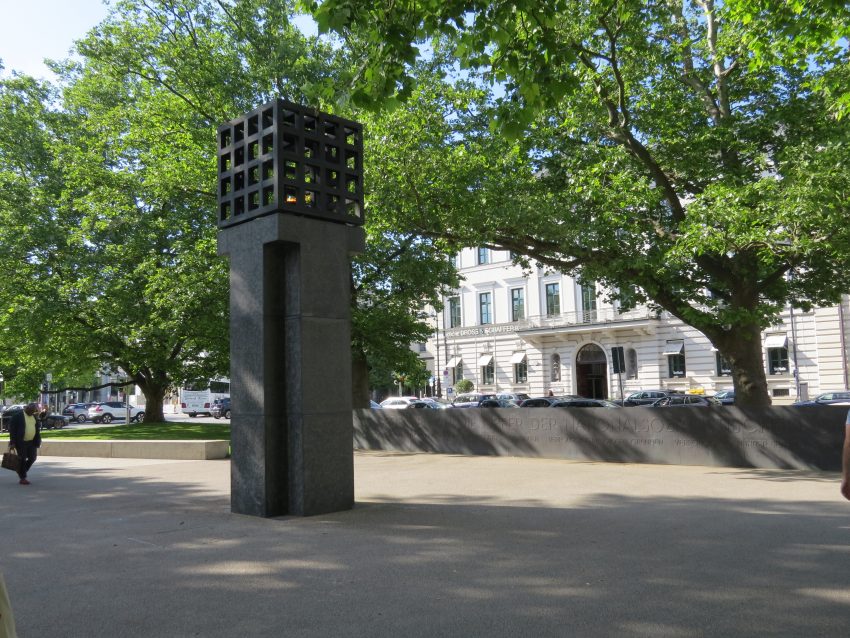Many people travel to Germany to learn more about the Second World War and the period of time when Germany was under NAZI rule. If the intent is to visit buildings and sites that were relevant to Hitler’s government at that time you will be sorely disappointed. Very little remains and what does has been repurposed in modern Germany. Nonetheless, it is still important to better understand that horrific time in our modern history.
We joined a walking tour while in Munich titled “Hitler and the Third Reich” as a way to learn more ourselves. The tour was 3 hours long, offered by Radius Tours and our excellent and informative guide was Josh. You can find out more about the tour itself at https://www.viator.com/tours/Munich/Hitler-and-the-Third-Reich-Munich-Walking-Tour/d487-2666REICH. I can highly recommend it. Although there is a lot of walking the guide makes frequent stops so you can rest while they expand upon what you are seeing and why.
The tour was a presentation of the current German perspective on the period of time the Nazis (short form of Nationalist Socialist Party) were in power. As a political party it first came into being in 1923 in Munich with Adolph Hitler rapidly moving into its top position. It was elected to lead the country, forming a totalitarian government, in 1933 and ended along with the war in 1945.
Nationalist Socialist Party) were in power. As a political party it first came into being in 1923 in Munich with Adolph Hitler rapidly moving into its top position. It was elected to lead the country, forming a totalitarian government, in 1933 and ended along with the war in 1945.
The tour focused on two things. First was a discussion on how Hitler and the Nazis came to power. This was accomplished through propaganda, lies and manipulation. Not all Germans were members of this party but it was a pervasive influence throughout society, enticing young and old alike. Although there was resistance, and an active movement against the party, they had money and power, including the backing of industry and upper society.
The second was on the persecution on those of Jewish faith. The Nazis did not start antisemitism nor was it exclusive to Germany, but they took it the farthest with the Holocaust. Hitler started by referring to the religion as a race, which made it easier to discriminate and persecute than a religion. Included in this was discrimination of any peoples that did not fit into the Nazi standard of a superior race, such as the disabled, homosexuals and Gypsies.
 The walk took us to a number of spots that were significant during that time. Our guide offered photos, news clippings and historical perspective of these parts of the city that we would otherwise not have known. The building that was the apartment and offices of Hitler is now the music department for the University of Munich. It was a building in existence before the war, as was many of the places used by the party. These were not bombed after the war but many new buildings that were actually build for the party’s purposes were destroyed to prevent them from being pilgrimage points for the party faithful.
The walk took us to a number of spots that were significant during that time. Our guide offered photos, news clippings and historical perspective of these parts of the city that we would otherwise not have known. The building that was the apartment and offices of Hitler is now the music department for the University of Munich. It was a building in existence before the war, as was many of the places used by the party. These were not bombed after the war but many new buildings that were actually build for the party’s purposes were destroyed to prevent them from being pilgrimage points for the party faithful.
Another stop was a square surrounded by three buildings now housing museums. This was the site of a book burning. The circle in the centre contains the names of the authors, many of them Jewish, whose works were destroyed. The former site of the Nazi Headquarters now contains a modern Documentation Centre. The Odeonplatz was where the rallies and marches took place remains as a monument to Germans lost in the Prussian wars. The Hofbrauhaus was a popular drinking hall for party members and is still a favourite tourist stop.
museums. This was the site of a book burning. The circle in the centre contains the names of the authors, many of them Jewish, whose works were destroyed. The former site of the Nazi Headquarters now contains a modern Documentation Centre. The Odeonplatz was where the rallies and marches took place remains as a monument to Germans lost in the Prussian wars. The Hofbrauhaus was a popular drinking hall for party members and is still a favourite tourist stop.
We also got to visit memorials, such as the eternal flame in memory of the murdered Jews, and plaques like the one in the city centre thanking the US Armed Forces who not only liberated the city from the Nazis at the end of WWII but also from communism in 1992.
The tour was sobering and informative. It addressed so many of the common misconceptions we had about what happened during that time. It has taken Germans decades to apologize and make amends and now the current generation hopes to educate others so it never happens again.
